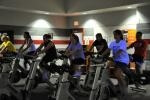Rosemary Dorsett>Junior>Journalism>University of Maryland
 The mind isn’t the only thing expanding as students enter college. A 2003 study conducted by Cornell University found that college freshman gain an average of 4.2 pounds during their first three months on campus, eating an average of 174 more calories than expended on a daily basis.
The mind isn’t the only thing expanding as students enter college. A 2003 study conducted by Cornell University found that college freshman gain an average of 4.2 pounds during their first three months on campus, eating an average of 174 more calories than expended on a daily basis.
But the dreaded “freshman 15” can be easily avoided if students establish a daily exercise routine and stock up on healthy alternatives to dining hall food and late-night meals.
“Almost always through the whole year there will be stress points. The key is to go into them with coping skills, and the biggest key is having a really low fat diet,” says Nutritionist Dr. Susan Kleiner. Through 30 years of experience, she developed the “Good Mood Diet,” based on the idea that any food in moderation can be a “feel good” food, especially nuts, seeds, olives, avocados and olive oil. “About 30 percent of your total daily calories should come from fats which keep cell membranes healthy,” says Kleiner.
Also, carefully monitor your caffeine intake and use it as a study tool only when absolutely necessary. “After a while, the more and more you have causes a rebound effect, and [it] loses its effectiveness,” Kleiner says.
Catherine Ziegler, co-founder of CRAVE Health, also recommends having pumpkin or sunflower seeds on hand as a study snack. “The seeds have magnesium which is a relaxing mineral and keeps your mind alert,” says Ziegler. Ziegler also recommends Lara Bars over other supplement foods because they are made with a few natural ingredients and combine carbohydrates found in fruit with the proteins in nuts to keep you full and focused longer.
If freshman year has come and gone and you’re still having a hard time shedding the extra pounds, the solution may be as close as the lecture hall. “You don’t need a lot of equipment to have a quality workout,” says Caity Davis, personal trainer and owner of FitOne Evolving Fitness studios in Washington, D.C. Davis recommends doing isometric contractions if you have back-to-back classes and don’t have time to get to the gym.
Try squeezing your glutes (your butt muscles) together for 10 seconds with a five-second rest, do a series of six, then work your way up. To target your abdominal muscles, really work on practicing good posture without using the back of your chair. Be sure to contract your core muscles like you are preparing to take a punch in the stomach. If your want to tone your arms, all you need is a sturdy desktop. By pushing down on the desk, you can tone your triceps; the opposite direction targets the biceps.
Basically, your brain doesn’t have to be the only thing exhausted after class.



















